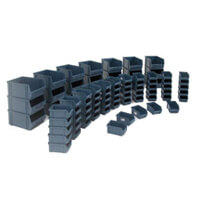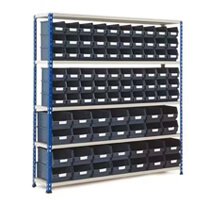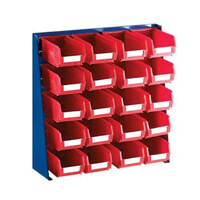
Well-organised storage bins are essential in order for a warehouse to operate smoothly. In a busy environment with lots of supplies separated in individual containers, it’s important to have a storage system designed where things can be found as easily and efficiently as possible.
There are several different types of storage bins available, from cardboard and plastic designs to models that can be shelved, stacked and slid into bays, panels and cupboards. They come in an array of different colours, sizes, shapes and materials, although plastic is the most common. As well as warehouses, storage bins are popular in offices and other workplaces, and they can be used to store anything from pencils to TVs.
It’s especially vital for businesses that regularly use lots of small parts, such as screws, bolts and nuts, to have an efficient storage system that means such items can be identified quickly.
How to organise large storage bins
Before planning how to organise the storage bins, you should examine the size of the intended storage space. If you require large storage bins, study the layout first and figure out where the optimal storage positions would be. To save space, you might consider installing shelving, cupboards or panels to support the bins around the perimeter.
Large storage bins can usually support over two cubic feet of items and can be organised in several ways. Labels are the most popular way to organise storage bins. Perhaps with your particular storage needs, a number or letter system would work best.
For instance, if you have rows, stacks and levels of storage bins, you could label the bin for items such as hammers in the format ‘A-01-02’, showing that you can find hammers in row A, stack 1 and level 2. For smaller environments, where there may only be one shelving bay, you could write the full description of supplies on a larger label per storage bin.
Larger workplaces should organise their storage bins in accordance with how much they are used. So, if there are lots of bins stacked up on shelves, the containers at the top should always hold the items which are the needed the least. If the top shelf is out of reach and only accessible by ladders, it’s worth placing outdated and excess items, damaged supplies and so on within the highest bins.
How to label storage bins
Labelling is crucial to help you identify which items are inside the storage bins, along with important product specifications and information. There are various ways storage bins can be labelled and a lot of it will come down to personal preference, but in certain industries, specific labelling systems will work more efficiently than others.
So, what are some of the ways storage bins can be labelled?
- Alphabetically
For lots of containers, labelling alphabetically usually works well. Similar to how books are indexed in a library, organise your storage bins from A-Z using the first letter of the inside contents as a guide. Be sure to keep an inventory of when and where the items were placed.
- Colour
You can buy bins in several different colours, and this can help you to make an efficient storage system. For example, a seamstress might store coloured thread and fabrics according to a similarly coloured storage bin. Alternatively, you could opt for coloured labels or attach coloured sticky dots and use a colour-coded filing system. Transparent boxes are useful for identifying products quickly, but you should still attach labels for clarity.
- Type of item
It might be easier to label your items by type and organise them in categories. For instance, a carpenter may keep their tools in storage bins with small printed images of the item attached to the label. They could be organised in groups, so different kinds of screws and nails should be placed next to each other with the type specified on the label.
- Size
Items that come in a variety of different sizes should have the size printed on the label. If a builder has bolts stored that range from three to 10 millimetres, the size should be labelled in a large and clear font. Note that bigger storage bins work better on lower shelves, with smaller boxes organised on the upper levels that may be harder to reach.
How to make labels for storage bins
Labels don’t necessarily need to be the traditional white sticky label. You can use a sharpie and write directly on cardboard and plastic storage bins, or hand write them on card or paper and stick them down with tape. Sticky labels are the most convenient option just in case you need to update the description, as you can simply stick a new label over the existing one. For a more professional appearance, opt for magnetic labels or printed labels using computer software.
View our extensive range of storage boxes and bins here!
Storage Bins, Boxes & Containers – Rapid Racking




Leave a Reply
You must be logged in to post a comment.